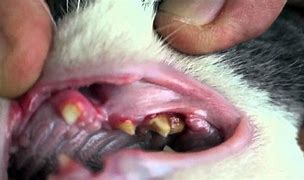By PetWellbeing

When your cat yawns, you might get a brief glimpse at what’s going on in their mouth. After taking a peek, cat owners often ask themselves, “Are my cat’s gums normal?”
The eyes might be the window to the soul, but the gums are the window to your cat’s oral health. Cats are masters at hiding illness, so inspecting the gums is a good place to start—if they let you!
If your cat is okay with it, check their gums on a regular basis to detect potential health concerns.
Traits of healthy cat gums
Gums with the following characteristics indicate your kitty is in good health.
- Pink color: Healthy cat gums are light pink in color. The ideal shade of pink is one that’s neither too bright nor too pale. Some cats, particularly black and orange ones, naturally have black or spotted gums. This is normal as long as the gums have been black their whole life. Double check with a vet to make sure black is a normal color for your cat’s gums.
- Slippery and wet: When you run a finger along your cat’s gums, they should feel slippery and coated in saliva. This is a good indicator that your kitty is well hydrated.
- Smooth texture: Healthy cat gums should feel smooth, not bumpy. Some cats develop black or brown spots that look like freckles as they get older. Pigmentation is a normal part of the aging process for some senior kitties so long as the gums still have a smooth texture.
Unhealthy gums and their diseases
Schedule a trip to the vet if you notice any of these abnormal characteristics.
- Red or bright pink gums: Redness indicates the presence of gingivitis when it appears around teeth or along the gum line. Gingivitis can progress to periodontal disease, in which case the entire gum line will look either red or bright pink. Gums that suddenly change to these colors could mean your cat is experiencing heat stroke. Heat stroke can quickly turn fatal and requires an immediate trip to the vet.
- Gums growing over teeth: Pet parents should be concerned if their cat’s teeth look like they’re sinking below the gum line. This is a clear sign of a dental disease called tooth resorption. Tooth resorption occurs when a tooth slowly deteriorates and gets absorbed back into the jaw bone. It’s a long, painful process that most older cats experience at some point in their life.
- Dry or tacky gums: Your cat’s gums shouldn’t feel sticky or dry to the touch. If that’s the case, your cat might be severely dehydrated. This symptom sometimes appears along with the redness associated with heat stroke. Encourage your kitty to drink lots of water right away. If the gum’s moisture doesn’t return to normal, you’ll need to visit an emergency clinic, where vets can rehydrate your cat.
- Blue, purple or gray gums: All of these colors are cause for immediate concern. Gums that have paled into a blue, purple or gray hue indicate your cat isn’t getting enough oxygen. This could be due to pneumonia or a blockage in the wind pipe. Don’t wait a second longer—these colors require immediate medical attention!
- White or pale pink gums: While blue indicates a lack of oxygen, white or pale pink gums mean your kitty has poor blood circulation. It’s possible their body isn’t producing enough red blood cells, but these colors could also be a warning sign for internal bleeding. Most cats who recently sustained an injury will exhibit white or pale pink gums. Check with your vet for a proper diagnosis.
- Bumps, craters or lesions: A bumpy gum texture usually indicates that something’s wrong. Cats develop bumps or lesions on their gums for a variety of reasons. In some cases, the bumps are malignant tumors associated with oral cancer. This is especially true if the bumps are quite painful. Gums that are pockmarked with craters or open sores could mean your kitty has a bacterial infection caused by poor dental hygiene. No matter the cause, anything other than a smooth texture warrants a trip to the vet.
If your cat seems off, their gums are the first place to look. A change in color, texture or moisture can speak volumes about your kitty’s health. While unhealthy gums can indicate a problem, pet parents shouldn’t jump to conclusions about what their cats may or may not be experiencing. Abnormal gum characteristics are your cue to visit a vet clinic where the experts can accurately determine the proper next steps.